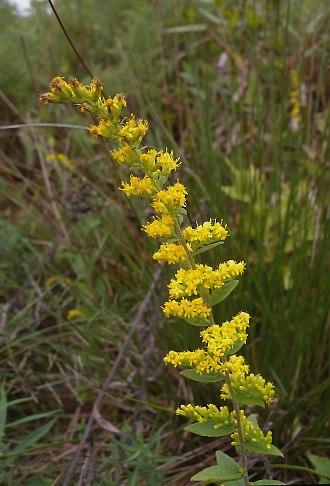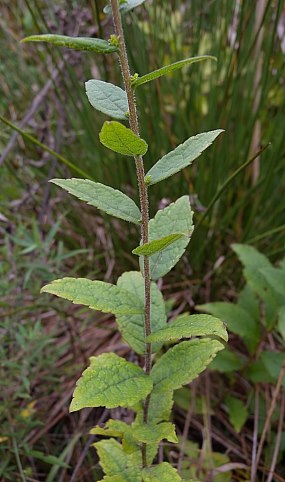Description: This perennial wildflower is 1-5' tall and either unbranched or sparingly so. The central stem is erect, terete, densely hairy or pubescent, and light green to brownish red. The alternate leaves are up to 4" long and 1½" across; they are ovate, narrowly ovate, ovate-lanceolate, or ovate-oblanceolate in shape with crenate-serrate margins. The upper surfaces of the leaves are deeply indented by pinnate veins; this characteristic provides them with a somewhat wrinkled appearance. Additionally, the upper surfaces of the leaves are slightly pubescent to hairless, medium to dark green, and usually dull-colored. The central stem terminates in a panicle of yellow flowerheads of variable shape and size. Small plants often have narrow panicles that resemble racemes, while large plants often have broad panicles with spreading-recurved branches. The upper stems of some large plants may produce panicles that are smaller than that of the central stem.

Each yellow
flowerhead spans about 1/8" (3 mm.) across,
consisting of 4-8 ray florets and a similar number of tubular disk
florets. The base of each flowerhead consists of overlapping scale-like
bracts that are yellowish-green. The branches of larger panicles often
have small leafy bracts. The blooming period can occur from mid-summer
into the fall and lasts about 1-2 months. Each fertile floret is
replaced by a small bullet-shaped achene with a short tuft of hairs at
its apex. The root system is fibrous and rhizomatous. Vegetative
colonies of plants are often formed by the spreading rhizomes.
Cultivation:
The preference is full sun to light
shade, moist conditions, and soil that is sandy, loamy, or gravelly
with a slightly acid pH.

Range & Habitat:
The native Wrinkled-Leaved Goldenrod occurs primarily in the southwest
corner of Illinois, where it is uncommon. Elsewhere in the state, it is
rare or absent (see Distribution
Map). Illinois lies at the NW range limit of this species.
Habitats include low open woodlands, thickets, sandy swamps, wet sandy
prairies, sandy banks of marshes, acid gravelly seeps, sand dunes, and
rocky bluffs or cliffs. Usually, this goldenrod is found in moist areas
that are sandy or where sandstone is close to the ground surface.
Sometimes it is found in gardens, although some cultivars of this
species bear little resemblance to the native plants.
Faunal Associations:
The nectar and pollen of the flowers attract a wide variety of insects,
including small bees, wasps, flies, small butterflies, skippers, and
beetles. Other insects feed destructively on the leaves, stems, and
other parts of Wrinkle-leaved Goldenrod (Solidago rugosa) and other
goldenrods (Solidago spp.). These insect feeders include larvae of leaf
beetles, larvae of leaf-mining flies, larvae of gall flies, larvae of
fruit flies, plant bugs, stink bugs, aphids, leafhoppers, treehoppers,
mealybugs, grasshoppers, larvae of twirler moths (Gelechiidae), larvae
of Geometer moths, larvae of owlet moths (Noctuidae), and larvae of
Tortrix moths. The Insect Table provides a more complete and detailed list of these species. Insectivorous birds benefit indirectly
from goldenrods because of the numerous insects that they attract.
Other birds feed directly on goldenrods to a minor extent, including
the Indigo Bunting (seeds), Eastern Goldfinch (seeds), Swamp Sparrow
(seeds), Ruffed Grouse (leaves), and Greater Prairie Chicken (leaves).
White-Tailed Deer and Cottontail Rabbits feed on young foliage to a
limited extent, while Meadow Voles eat both the seeds and foliage.
Photographic Location:
A sandy bank along a marsh at Jasper-Pulaski Fish and Wildlife Area in
northwestern Indiana. The photographed plant is a dwarf (about 1½'
tall) that may have been mowed earlier in the year.
Comments:
Across it range in the eastern United States, this goldenrod is
somewhat variable in appearance. Nonetheless, Wrinkle-Leaved Goldenrod
can be distinguished from other goldenrods as follows: 1) the central
stem is quite hairy or pubescent, 2) the upper surfaces of the leaves
have a wrinkled appearance because of the indentations of their pinnate
veins, and 3) individual leaves lack 3 prominent veins that run
parallel to each other. This latter characteristic is typical of Solidago
canadensis (Canada Goldenrod), Solidago gigantea
(Giant Goldenrod), and similar goldenrods. Two other species, Solidago
ulmifolia (Elm-Leaved Goldenrod) and Solidago patula
(Swamp Goldenrod), have stems that are glabrous or only slightly hairy
and their leaves tend to be more thin in texture and shiny than those
of Wrinkle-Leaved Goldenrod. Other common names of Solidago
rugosa include 'Rough-Stemmed Goldenrod,' 'Rough Goldenrod,'
and 'Rough-Leaved Goldenrod.'